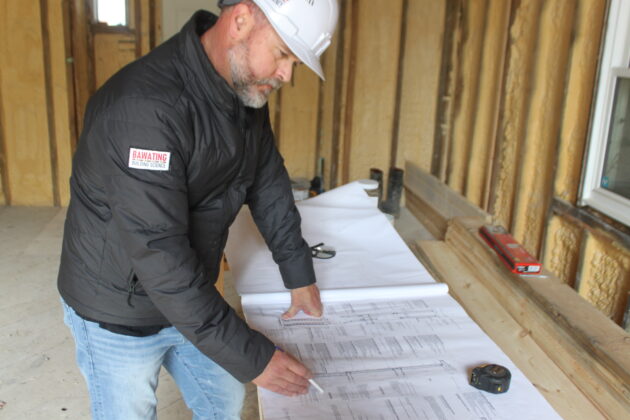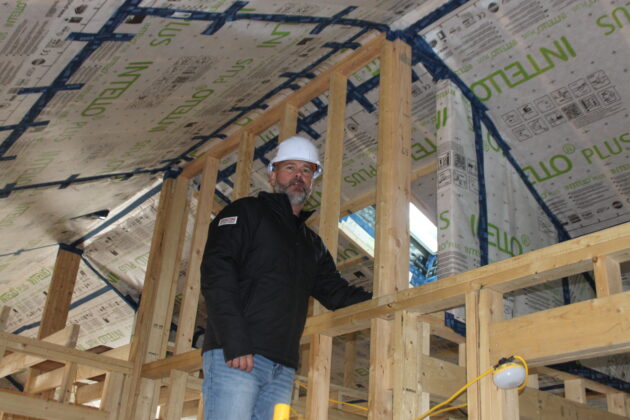
A passion for science and building led Bawating Building Science president, Trevor Trainor, into the world of Indigenous housing issues and tasked him with the mission of how to improve them.
After 10 years in automotive assembly ergonomics, Trainor began his journey into building sciences. Deciding to pursue his passion for building, he began building himself a cottage and started up a residential construction company.

Photo courtesy of Trevor Trainor
After six years, he came to realize there was more to it – high performance homes. Intrigued, Trainor enrolled himself at the University of Waterloo in their Master of Applied Sciences program, with a specialized focus on building sciences. During his time in the program, he worked alongside Dr. John Straube.
“Dr. Straube is one of the true experts in the industry. I started working for his firm, Building Science Labs, where I was surrounded by other experts in the field who taught me more about building science and helped to accelerate my education,” said Trainor.
Upon graduation, Trainor joined the Building Science Labs team and worked there for eight years, continually learning from his peers.
After his time at Building Science Labs, Trainor founded Bawating Building Science, his own consulting firm, after a joint venture fell through.
“I was ready to pursue my passion and focus my expertise full-time on Indigenous housing issues.”
Trainor said the goal with Bawating is to “provide exceptional building science services for Indigenous communities across Turtle Island (North America) and to make a significant contribution to solving the Indigenous housing crisis.”
Overcrowding and poor housing issues are major issues in Indigenous communities across Canada. According to a 2018 Canadian Housing Survey, Indigenous people were nearly three times more likely to report dissatisfaction with their dwelling’s energy efficiency, with 20.1 per cent reporting dissatisfaction with their dwelling’s ability to maintain a comfortable temperature in summer and 17.7 per cent in the winter.
In 2021, one in six Indigenous people lived in crowded housing. Statistics Canada also reported that Indigenous people were almost three times more likely to live in a dwelling in need of major repairs (16.4 per cent) in 2021 than the non-Indigenous population (5.7 per cent).
These issues and trends led Trainor, a member of the Thessalon First Nation, to look toward finding solutions to these problems.
Bawating Building Science focuses on projects related to building enclosures. This focus includes providing services related to design, analysis, testing and research of building enclosure systems as well as forensic investigation related to building moisture issues.
For Trainor, education about these issues is equally as important as fixing them.
“We also develop and deliver educational programming for other industry professionals on related topics. We collaborate regularly with other consulting firms such as Building Enclosure Labs Inc., Building Knowledge Canada, and Construction Instruction.”
Northern speciality
Bawating is currently working on a project with Dillon Consulting and Nunavut Housing Corporation to develop and monitor residential retrofit strategies.
“There are significant problems related to mold and the rot and decay of unvented roof systems throughout Nunavut. Our remediation project involved developing and analyzing two strategies to retrofit these roof systems,” said Trainor.
The analysis has included an extensive hygrothermal modeling study to determine the most effective retrofit approaches.
“In the pilot phase of the retrofit work, the team has instrumented the roof systems with temperature, relative humidity and moisture content sensors during the construction process, and have remotely monitored the thermal and moisture performance of the retrofitted roofs.”
For Trainor, his hope is that this data will be used to further inform future retrofit and new roof designs in Nunavut, along with other regions in the Inuit Nunangat.
In his pursuit of improving Indigenous housing conditions, Trainor said that he is guided by what he sees as three crucial priorities for sustainable building design and construction: safety, and durability.
“Only once we have addressed the issues of fire susceptibility, poor indoor air quality, mould growth and premature deterioration of our buildings, can we then address energy efficiency,” said Trainor.
As trends in the construction industry continue to shift, Trainor’s hope is that housing health and durability stay in focus.
“I see emerging trends like modular housing, energy neutral buildings and embodied carbon accounting. While these are important and interesting areas of study, my focus is on building enclosure design for the far North, where extreme climates and over-crowded conditions are resulting in mould, poor indoor air quality and rapid decay of the buildings.”

Photo courtesy of Trevor Trainor
Trainor believes that collaboration is key for effectively addressing these efforts. Building science walks the line between design and construction, something he says is important to its development. Working with other industry professionals has allowed Trainor to adopt a “work smarter, not harder” philosophy, which keeps him motivated and eager to do meaningful work.
For Trainor, success is a long game that can be hard to capture but is incredibly meaningful when achieved.
“Measuring the success of our projects is a difficult task,” he said. “Customer satisfaction is certainly one measure but to truly evaluate our contribution to the development of healthy, durable, and efficient housing is something that occurs in the long-term.”
Growing the industry
While the demand for building is growing, so is the need for build science expertise.
“There is no better time than now to get into building science. The demand to help restore our existing building stock or creating the next generation of buildings is high,” said Trainor.
The avenues in building science consulting are endless, including design review, energy modeling, field review, forensics, and research. Exposure is key, Trainor recommends those interested in building sciences explore their options.
“Compared to other industries, construction is slow to change. While there are definitely groups working on the leading edge, others can be slow to adapt and adopt.”
Learning and education is an ongoing process at Bawating Building Science, with Trainor leveraging every opportunity their team has for exposure in the industry into a chance of growing their knowledge base.
“We are always reviewing information related to the latest developments in building materials, approaches to design, construction techniques and analysis to understand how these developments can apply to our work in Indigenous housing,” said Trainor. “ The learning never stops.”
Looking to the future
For Trainor, the future of Bawating Building Science is clear: to continue to make significant contributions to solving the Indigenous housing crisis.
This goal is about more than just getting shovels in the ground for Trainor. Bawating’s vision also includes contributing to building science expertise and teaching building science principles to others in the Indigenous housing space, as well as training the next generation of Indigenous housing professionals.
In their first two years of operation, Bawating has been actively involved in achieving these goals, and Trainor looks forward to the future of what they will achieve.
“I’m pleased with the work we have done so far, but we are just getting started.”

Leave a Reply